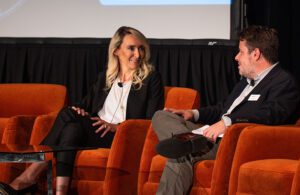
Celine Martin, Johnson & Johnson group chair, cardiovascular & specialty solutions (CSS) group, oversees high-growth areas at the company’s global MedTech business.
Her leadership covers Acclarent, Biosense Webster, Cerenovus and Mentor. Together, those companies bring in more than $5 billion in annual sales with more than 14,000 employees.
Over 25 years at Johnson & Johnson, Martin has looked to improve standards of care for AFib, stroke and minimally invasive surgery. At DeviceTalks West in Santa Clara last week, she spoke in a keynote address about how she’s done it.
On treating AFib at Biosense Webster
Martin said at DeviceTalks that BioSense Webster represents one of the J&J MedTech companies in a leadership position. She said it holds a 54% market share.
Its aim, she noted, is to provide treatment for AFib. Earlier this month, the company launched its HelioStar balloon ablation catheter in Europe. Catheter ablation is generally associated with improved quality of life and significant reductions in AFib burden.
The company designed the radiofrequency balloon ablation catheter for catheter-based cardiac electrophysiological mapping of the atria when used with a multi-channel RF generator. It represents the latest step forward for Johnson & Johnson and Biosense Webster to reach their goals.
“We have elected, as a leadership team, to truly be dedicated to atrial fibrillation,” said Martin. “This is a core mission of ours to cure AFib and I remember, many years back, in the boardroom, we decided that we were going to make this happen. [There were] a lot of naysayers in the world, knowing that the first line of therapy at the time used to be [taking] drugs. We’ve never stopped innovating.”
Martin added that she’s “humbled” to say the company achieved “true standard of care” for ablation. She cited a success rate rising north of 90%.
However, it doesn’t stop there.
“It doesn’t stop here because there’s a massive under-penetration of therapy,” said Martin. “We’re touching about a million patients a year, and yet we’re only treating 10% of the population that should be entering.”
About the process
Martin said a unique aspect of J&J’s work is its tandem efforts with physicians.
She said the company develops technologies together with them to help solve the different dimensions of unmet needs. At the end of the day, she figures, it helps to tell the company what moves the needle and helps to deliver better technologies.
“Simplify procedures,” Martin said. “Locate where to ablate. Really make it a procedure that is turnkey and doesn’t have to be at the mercy of the operator experience.”
Patients also often get dismissed in the process, Martin explained. They can remain on medications for a long time and experience plenty of side effects.
According to her, the sooner they get on ablation, the better. Responsibility rests with Johnson & Johnson to educate the proper channels about getting patients the right solutions.
“At the very end of the day, it’s first about being in the hands of the right caregiver,” she added. “We’re doing a lot around raising awareness. Second is making sure that patients do not get lost in the care pathway.”
The ‘burgeoning’ space of pulsed-field ablation
Pulsed-field ablation (PFA), a non-thermal method for cardiac ablation, is a hot topic in medtech. It has the potential to positively disrupt the way AFib is treated.
“It’s definitely a burgeoning space,” said Martin. “And there’s still evolution.”
She describes it as a new chapter in the “ablation book,” but not a new book itself.
The current method for treating AFib, RF ablation, still has some drawbacks, she said. The delivery of energy can range anywhere from 12 seconds to 60 seconds. If you burn for too long, it not only injures the structure you ablate, but the surrounding ones, too. Some of those injuries, while rare, are considered serious.
Martin asks a simple question: How do you produce effectiveness while still minimizing the risk of these injuries?
J&J remains committed to its effort to produce these outcomes. This includes its 3D navigation, which Martin said helps with the “critical” idea of knowing your precise location at all times. It also includes a wide array of catheters, which Martin hopes gives the company a leg up in the market.
“The approach we’re taking is ,we’re not first to market, but, we’re — in my mind leading — the race,” said Martin. “We have a vision, and that is, we want to provide clinicians with the same portfolio that exists today in radiofrequency and make it PF-enabled.”
On innovation
“If you want to go fast, go alone,” Martin said. “If you want to go forward, go together.”
That’s Martin’s take on innovation. It helps, she said, that Johnson & Johnson can benefit from the “unique machine” of the San Francisco–area medtech hub.
One example she provided was the integration of Acclarent in Irvine, California, within the CSS group at J&J. The company decided it needed to expand and leverage its navigational technology within Biosense Webster and design technology to be in service of Acclarent’s ear, nose and throat treatments.
Martin said the company saw a clinical benefit and simply acted on it.
“To me, this speaks to the benefits of harnessing the technology and innovation we have in one part of the company and making it in service of the different parts,” said Martin.
Next steps in J&J innovation include another up-and-coming space: digital. COVID-19 accelerated digital dependencies, Martin said. The company no longer develops just simple devices, as some must be sensor-enabled and connectable.
From robotics to catheters, the company is building on the need to collect data, Martin explained.
“We have software companies all over this portfolio,” said Martin. “For us, it’s not so much a transformation as it is an evolution. But, it’s amplified by a beautiful thing in culture-changing technologies. We’re building ecosystems.”